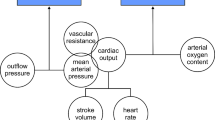Abstract
The aim of this study was to investigate the influence of critically low cardiac output (CO) upon oxygen transport. We especially focused on the changes of mixed venous oxygen saturation (S−vO2) in the presence of oxygen consumption (\(\dot VO_2 \)) debts. Additionally, we examined the correlation between the cumulative oxygen deficit (Def\(\dot VO_2 \)) and serum lactate. Def\(\dot VO_2 \) was calculated as the integrated area under the tissue\(\dot VO_2 \)) deficit (baseline\(\dot VO_2 \)-acutal\(\dot VO_2 \)) and time curve. To produce severe low CO, we performed openchest cardiopulmonary resuscitation (CPR) in 11 anesthetized dogs for 1 h. We made the measurements before (baseline values) and during the CPR at 10-min intervals. Supplydependent\(\dot VO_2 \) was observed when CO decreased below 40 ml·min−1·kg−1. The mean value of S−vO2 in the range of supply-dependent\(\dot VO_2 \) was 13±2% and did not change significantly during 1 h of CPR. The changes of lactate from baseline values were linearly correlated with Def\(\dot VO_2 \) (r=0.62,P<0.01), but absolute values of serum lactate were not.
Similar content being viewed by others
References
Schumacker PT, Cain SM (1987) The concept of a critical oxygen delivery. Intensive Care Med 13:223–229
Shoemaker WC (1987) Circulatory mechanisms of shock and their mediators. Crit Care Med 15:787–794
Weg JG (1991) Oxygen transport in adult respiratory distress syndrome and other acute circulatory problems: Relationship of oxygen delivery and oxygen consumption. Crit Care Med 19:650–657
Handeln KB, Gronemeyer R, Held A, et al. (1991) Use of continuous noninvasive measurement of oxygen consumption in patients with adult respiratory distress syndrome following shock of various etiologies. Crit Care Med 19:642–649
Tuchschmidt J, Oblitas D, Fried JC (1991) Oxygen consumption in sepsis and septic shock. Crit Care Med 19:664–671
Edwards JD (1991) Oxygen transport in cardiogenic and septic shock. Crit Care Med 19:658–663
Creamer JE, Edwards JD, Nightingale P (1990) Hemodynamic and oxygen transport variables in cardiogenic shock secondary to acute myocardial infarction and response to treatment. Am J Cardiol 65:1297–1300
Schlichtig R, Pinsky MR (1988) Defining the hypoxic threshold. Crit Care Med 19:147–149
Shoemaker WC, Appel PL, Kram HB (1988) Tissue oxygen debt as a determinant of lethal and nonlethal postoperative organ failure. Crit Care Med 16:1117–1120
Leavy JA, Weil MH, Rachow EC (1988) Lactate washout following circulatory arrest. JAMA 260:662–665
Mizock BA, Falk JL (1992) Lactic acidosis in critical illness. Crit Care Med 20:80–93
Stetz CW, Miller RG, Kelly GE (1982) Reliability of thermodilution method in the determination of cardiac output in clinical practice. Am Rev Respir Dis 126:1001–1004
Jones NL (1988) Clinical exercise testing, 3rd edn. WB Saunders, Philadelphia, pp 28–34, 46–50
Wagner PD (1987) Handbook of physiology, the respiratory system volume IV. Bethesda. American Physiological Society, pp 257–281
Lowenstein E, Reiz S (1987) Effects of inhalation anesthetics on systemic hemodynamics and the coronary circulation. In: Kaplan JA (ed) Cardiac Anesthesia, 2nd edn. Grune and Stratton, Orlando, pp 3–31
Author information
Authors and Affiliations
About this article
Cite this article
Fukui, M., Hatanaka, T., Yoshioka, M. et al. Changes of oxygen transport variables and serum lactate during open-chest cardiac massage in dogs. J Anesth 8, 72–77 (1994). https://doi.org/10.1007/BF02482759
Received:
Accepted:
Issue Date:
DOI: https://doi.org/10.1007/BF02482759




